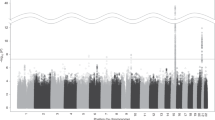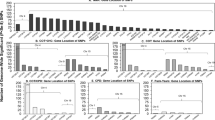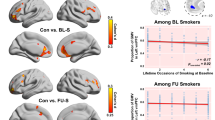Abstract
Despite the health hazards, cigarette smoking is disproportionately frequent among young women. A significant contribution of genetic factors to smoking phenotypes is well established. Efforts to identify susceptibility genes do not generally take into account possible interaction with environment, life experience and psychological characteristics. We recruited 501 female Israeli students aged 20–30 years, obtained comprehensive background data and details of cigarette smoking and administered a battery of psychological instruments. Smoking initiators (n=242) were divided into subgroups with high (n=127) and low (n=115) levels of nicotine dependence based on their scores on the Fagerstrom Tolerance Questionnaire and genotyped with noninitiators (n=142) for single nucleotide polymorphisms (SNPs) in 11 nicotinic cholinergic receptor genes. We found nominally significant (P<0.05) allelic and genotypic association with smoking initiation of SNP rs2072660 and multilocus haplotypes (P<0.007–0.05) in CHRNB2 and nominal (P<0.05) allelic or genotypic association of SNPs in CHRNA7 (rs1909884), CHRNA9 (rs4861065) and CHRNB3 (rs9298629) with nicotine dependence. Employing logistic regression and controlling for known risk factors, the best-fitting model for smoking initiation encompassed a 5 SNP haplotype in CHRNB2, neuroticism and novelty seeking (P=5.9 × 10−14, Nagelkerke r2=0.30). For severity of nicotine dependence, two SNPs in CHRNA7 (rs1909884 and rs883473), one SNP in CHRNA5 (rs680244) and the interaction of a SNP in CHRNA7 (rs2337980) with neuroticism, were included in the model (P=2.24 × 10−7, Nagelkerke r2=0.40). These findings indicate that background factors, psychological characteristics and genetic variation in nicotinic cholinergic receptors contribute independently or interactively to smoking initiation and to severity of nicotine dependence in young women.
This is a preview of subscription content, access via your institution
Access options
Subscribe to this journal
Receive 12 print issues and online access
$259.00 per year
only $21.58 per issue
Buy this article
- Purchase on Springer Link
- Instant access to full article PDF
Prices may be subject to local taxes which are calculated during checkout
Similar content being viewed by others
References
World Health Organization, Regional Office for Europe. WHO European Country Profiles on Tobacco Control, WHO, Geneva, 2005.
US Department of Health and Human Services. Women and smoking: a report of the Surgeon General. Centers for Disease Control and Prevention, National Center for Chronic Disease Prevention and Health Promotion, Office on Smoking and Health. 2001.
Israel Ministry of Health. Report on Smoking in Israel 2003–2004. Israel Ministry of Health, May 2004.
US Department of Health and Human Services. Preventing tobacco use among young people. US Department of Health and Human Services, Public Health Service, Centers for Disease Control and Prevention, National Center for Chronic Disease Prevention and Health Promotion, Office on Smoking and Health. 1994.
Barman SK, Pulkkinen L, Kaprio J, Rose RJ . Inattentiveness, parental smoking and adolescent smoking inititiation. Addiction 2004; 99: 1049–1061.
Tyc VL, Hadley W, Allen D, Ey S, Rai SN, Lensing S . Predictors of smoking intentions and smoking status among nonsmoking and smoking adolescents. Addict Behav 2004; 29: 1143–1147.
Harakeh Z, Scholte RH, Vermulst AA, de Vries H, Engels RC . Parental factors and adolescents' smoking behavior: an extension of the theory of planned behavior. Prev Med 2004; 39: 951–961.
Tilson EC, McBride CM, Lipkus IM, Catalono RF . Testing the interaction between parent-child relationship factor and parent smoking to predict youth smoking. J of Adol Health 2004; 35: 182–189.
Wilkinson D, Abraham C . Constructing an integrated model of the antecedents of adolescent smoking. Br J Health Psychol 2004; 9 (Part 3): 315–333.
Pomerleau CS, Pomerleau OF, Flessland KA, Basson SM . Relationship of Tridimensional Personality Questionnaire scores and smoking variables in female and male smokers. J Subst Abuse 1992; 4: 143–154.
Kremer I, Bachner-Melman R, Reshef A, Broude L, Nemanov L, Gritsenko I et al. Association of the serotonin transporter gene with smoking behavior. Am J Psychiatr 2005; 162: 924–930.
Kendler KS, Neale MC, Sullivan P, Corey LA, Gardner CO et al. A population-based twin study in women of smoking initiation and nicotine dependence. Psychol Med 1999; 29: 299–308.
Kim YH . Korean adolescents' smoking behavior and its correlation with psychological variables. Addict Behav 2005; 30: 343–350.
Kardia SL, Pomerleau CS, Rozek LS, Marks JL . Association of parental smoking history with nicotine dependence, smoking rate, and psychological cofactors in adult smokers. Addict Behav 2003; 28: 1447–1452.
Madden PA, Madden F, Bucholz KK, Dinwiddie SH, Slutske WS, Bierut LJ et al. Nicotine withdrawal in women. Addiction 1997; 92: 889–902.
Stolerman IP, Jarvis MJ . The scientific case that nicotine is addictive. Psychopharmacology (Berlin) 1995; 117: 2–10.
Sullivan PF, Kendler KS . The genetic epidemiology of smoking. Nicotine Tobacco Res 1999; 1 (Suppl 2): S51–S57; discussion S69–S70.
Li, MD, Cheng R, Ma JZ, Swan GE . A meta-analysis of estimated genetic and environmental effects on smoking behavior in male and female adult twins. Addiction 2003; 98: 23–31.
Niu T, Chen C, Ni J, Wang B, Fang Z, Shao H et al. Nicotine dependence and its familial aggregation in Chinese. Int J Epidemiol 2000; 29: 248–252.
Koob GF . Neural mechanisms of drug reinforcement. Ann N Y Acad Sci 1992; 654: 171–191.
Rossing MA . Genetic influences on smoking: candidate genes. Environ Health Perspect 1998; 106: 231–238.
Gotti C, Clementi F . Neuronal nicotinic receptors: from structure to pathology. Prog Neurobiol 2004; 74: 363–396.
Laviolette SR, van der Kooy D . The neurobiology of nicotine addiction: bridging the gap from molecules to behaviour. Nat Rev Neurosci 2004; 5: 55–65.
Rang HP, Dale MM, Ritter JM, Moore PK . Pharmacology, 5th edn Livingstone: Churchill, 2003.
Hogg RC, Raggenbass M, Bertrand D . Nicotinic acetylcholine receptors: from structure to brain function. Rev Physiol Biochem Pharmacol 2003; 147: 1–46.
Feng Y, Niu T, Xing H, Xu X, Chen C, Peng S et al. A common haplotype of the nicotine acetylcholine receptor alpha 4 subunit gene is associated with vulnerability to nicotine addiction in men. Am J Hum Genet 2004; 75: 112–121.
Li MD, Beuten J, Ma JZ, Payne TJ, Lou XY, Garcia V et al. Ethnic- and gender-specific association of the nicotinic acetylcholine receptor {alpha}4 subunit gene (CHRNA4) with nicotine dependence. Hum Mol Genet 2005; 14: 1211–1219.
Tapper AR, McKinney SL, Nashmi R, Schwarz J, Deshpande P, Labarca C et al. Nicotine activation of alpha4* receptors: sufficient for reward, tolerance, and sensitization. Science 2004; 306: 1029–1032.
Hogg RC, Bertrand D . Neuroscience. What genes tell us about nicotine addiction. Science 2004; 306: 983–985.
Silverman MA, Neale MC, Sullivan PF, Harris-Kerr C, Wormley B, Sadek H et al. Haplotypes of four novel single nucleotide polymorphisms in the nicotinic acetylcholine receptor beta2-subunit (CHRNB2) gene show no association with smoking initiation or nicotine dependence. Am J Med Genet 2000; 96: 646–653.
Lueders KK, Hu S, McHugh L, Myakishev MV, Sirota LA, Hamer DH . Genetic and functional analysis of single nucleotide polymorphisms in the beta2-neuronal nicotinic acetylcholine receptor gene (CHRNB2). Nicotine Tob Res 2002; 4: 115–125.
Salas R, Pieri F, De Biasi M . Decreased signs of nicotine withdrawal in mice null for the beta4 nicotinic acetylcholine receptor subunit. J Neurosci 2004; 10: 10035–10039.
Maskos UBE, Molles S, Pons M, Besson BP, Guiard JP, Guilloux A et al. Nicotine receptors reinforcement and cognition restored by targeted expression of nicotinic. Nature 2005; 436: 103–107.
De Luca V, Wong AH, Muller DJ, Wong GW, Tyndale RF, Kennedy JL . Evidence of association between smoking and alpha7 nicotinic receptor subunit gene in schizophrenia patients. Neuropsychopharmacology 2004; 29: 1522–1526.
Faraone SV, Su J, Taylor L, Wilcox M, Van Eerdewegh P, Tsuang MT . A novel permutation testing method implicates sixteen nicotinic acetylcholine receptor genes as risk factors for smoking in schizophrenia families. Hum Hered 2004; 57: 59–68.
Freedman R, Leonard S, Gault JM, Hopkins J, Cloninger CR, Kaufmann CA et al. Linkage disequilibrium for schizophrenia at the chromosome 15q13–14 locus of the alpha7-nicotinic acetylcholine receptor subunit gene (CHRNA7). Am J Med Genet 2001; 8: 20–22.
Leonard S, Gault J, Hopkins J, Logel J, Vianzon R, Short M et al. Association of promoter variants in the alpha7 nicotinic acetylcholine receptor subunit gene with an inhibitory deficit found in schizophrenia. Arch Gen Psychiatr 2002; 59: 1085–1096.
Martin LF, Kem WR, Freedman R . Alpha-7 nicotinic receptor agonists: potential new candidates for the treatment of schizophrenia. Psychopharmacology 2004; 174: 54–64.
Fagerstrom KO . Measuring degree of physical dependence to tobacco smoking with reference to individuation of treatment. Addict Behav 1978; 3: 235–241.
Derogatis LR 1993)). Brief Symptom Inventory (BSI): Administration, Scoring and Procedures Manual, 3rd edn, National Computer Systems: Minneapolis, MN.
Garner DM, Garfinkel PE . The Eating Attitudes Test: an index for the symptoms of anorexia nervosa. Psychol Med 1979; 9: 273–279.
Bartholomew K, Horowitz LM . Attachment styles among young adults: a test of a four-category model. J Person Social Psychol 1991; 61: 226–244.
Procidano ME, Heller K . Measures of perceived social support from friends and from family: three validation studies. Am J Comm Psych 1983; 11: 1–21.
Parker G, Tubling H, Brown LB . A parental bonding instrument. British J Med Psych 1979; 52: 1–10.
Olson DH, Bell R, Portner J . Family Adaptability and Cohesion Evaluation Scales, FACES-II, Family Inventories Manual: Life Innovations, 1992.
Cloninger CR, Przybeck TR, Svrakic DM . Tridimensional Personality Questionnaire: US Normative Data. Psychol Rep 1991; 69: 1047–1057.
Bonfield JK, Smith KF, Staden R . A new DNA sequence assembly program. Nucl Acids Res 1995; 23: 4992–4999.
Little DP, Braun A, Darnhofer-Demar B, Frilling A, Li Y, McIver Jr RT et al. Detection of RET proto-oncogene codon 634 mutations using mass spectrometry. J Mol Med 1997; 75: 745–750.
Little DP, Braun A, Darnhofer-Demar B, Koster H . Identification of apolipoprotein E polymorphisms using temperature cycled primer oligo base extension and mass spectrometry. Eur J Clin Chem Clin Biochem 1997; 35: 545–548.
McCullough RM, Cantor CR, Ding C . High-throughput alternative splicing quantification by primer extension and matrix-assisted laser desorption/ionization time-of-flight mass spectrometry. Nucl Acids Res 2005; 33: 99.
Stephens M, Smith NJ, Donnelly P . A new statistical method for haplotype reconstruction from population data. Am J Hum Genet 2001; 68: 978–989.
Stephens M, Donnelly P . A comparison of Bayesian methods for haplotype recontstruction from population genotype data. Am J Hum Genet 2003; 73: 1162–1169.
Hosmer D, Lemeshow S . Applied Logistic Regression, 2nd edn Wiley Interscience: New York, 2000.
Gerra G, Garofano L, Zaimovic A, Moi G, Branchi B, Bussandri M et al. Association of the serotonin transporter promoter polymorphism with smoking behavior among adolescents. Am J Med Genet B Neuropsychiatr Genet 2005; 135: 73–78.
Hu S, Brody CL, Fisher C, Gunzerath L, Nelson ML, Sabol SZ et al. Interaction between the serotonin transporter gene and neuroticism in cigarette smoking behavior. Mol Psychiatr 2000; 5: 181–188.
Lerman C, Caporaso NE, Audrain J, Main D, Boyd NR, Shields PG . Interacting effects of the serotonin transporter gene and neuroticism in smoking practices and nicotine dependence. Mol Psychiatr 2000; 5: 189–192.
Reuter M, Hennig J . Pleiotropic effect of the TPH A779C polymorphism on nicotine dependence and personality. Am J Med Genet B Neuropsychiatr Genet 2005; 134: 20–24.
Audrain-McGovern J, Lerman C, Wileyto EP, Rodriguez D, Shields PG . Interacting effects of genetic predisposition and depression on adolescent smoking progression. Am J Psychiatr 2004; 161: 1224–1230.
Munafo M, Johnstone E, Murphy M, Walton R . New directions in the genetic mechanisms underlying nicotine addiction. Addict Biol 2001; 6: 109–117.
Van den Bree MB, Whitmer MD, Pickworth WB . Predictors of smoking development in a population-based sample of adolescents: a prospective study. J Adolesc Health 2004; 35: 172–181.
Baron-Epel O, Haviv-Messika A, Tamir D, Nitzan-Kaluski D, Green M . Mutiethnic differences in smoking in Israel: pooled analysis from three national surveys. Eur J Public Health 2004; 14: 384–389.
Zimlichman E, Kochba I, Mimouni FB, Schochat T, Grotto I, Kreiss Y et al. Smoking habits and obesity in young adults. Addiction 2005; 100: 1021–1025.
Delnevo CD, Hrywna M, Abatemarco DJ, Lewis MJ . Relationships between cigarette smoking and weight control in young women. Family Community Health 2003; 26: 140–146.
Acierno RA, Kilpatrick DG, Resnick HS, Saunders BE, Best CL . Violent assault, posttraumatic stress disorder, and depression. Risk factors for cigarette use among adult women. Behav Modif 1996; 20: 363–384.
Pfefferbaum B, Vinekar SS, Trautman RP, Lensgraf SJ, Reddy C, Patel N et al. The effect of loss and trauma on substance use behavior in individuals seeking support services after the 1995 Oklahoma City bombing. Ann Clin Psychiatr 2002; 14: 89–95.
Vlahov D, Galea S, Resnick H, Ahern J, Boscarino JA, Bucuvalas M et al. Increased use of cigarettes, alcohol and marijuana among Manhattan, New York, residents after the September 11 terrorists attacks. Am J Epidemiol 2002; 155: 988–996.
Agid O, Shapira B, Zislin J, Ritsner M, Hanin B, Murad H et al. Environment and vulnerability to major psychiatric illness: a case control study of early parental loss in major depression, bipolar disorder and schizophrenia. Mol Psychiatr 1999; 4: 163–172.
Gabriel SB, Schaffner SF, Nguyen H, Moore JM, Roy J, Blumenstiel B et al. The structure of haplotype blocks in the human genome. Science 2002; 296: 2225–2229.
Acknowledgements
Research described in this article was supported in part by Philip Morris USA Inc. and Philip Morris International (investigator designed, independently reviewed grant), the Genome Infrastructure Program of the Israeli Ministry of Science and Technology and the Crown Human Genome Center at the Weizmann Institute of Science. The authors thank Naomi Boumard and Professor Benny Yakir for their helpful advice.
Author information
Authors and Affiliations
Corresponding author
Additional information
Supplementary Information accompanies the paper on the Molecular Psychiatry website (http://www.nature.com/mp).
Supplementary information
Rights and permissions
About this article
Cite this article
Greenbaum, L., Kanyas, K., Karni, O. et al. Why do young women smoke? I. Direct and interactive effects of environment, psychological characteristics and nicotinic cholinergic receptor genes. Mol Psychiatry 11, 312–322 (2006). https://doi.org/10.1038/sj.mp.4001774
Received:
Revised:
Accepted:
Published:
Issue Date:
DOI: https://doi.org/10.1038/sj.mp.4001774
Keywords
This article is cited by
-
Significant association of the CHRNB3-CHRNA6 gene cluster with nicotine dependence in the Chinese Han population
Scientific Reports (2017)
-
A pilot study on commonality and specificity of copy number variants in schizophrenia and bipolar disorder
Translational Psychiatry (2016)
-
Crucial roles of the CHRNB3–CHRNA6 gene cluster on chromosome 8 in nicotine dependence: update and subjects for future research
Translational Psychiatry (2016)
-
The contribution of rare and common variants in 30 genes to risk nicotine dependence
Molecular Psychiatry (2015)
-
Biomarkers of Response to Smoking Cessation Pharmacotherapies: Progress to Date
CNS Drugs (2015)



